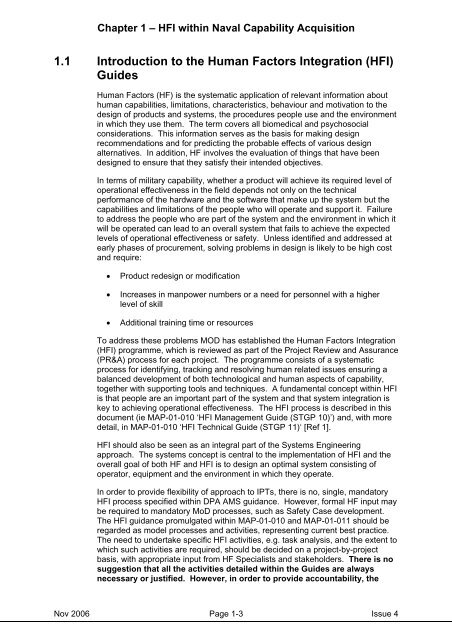MAP-01-010 HFI Management Guide - Human Factors Integration ...
MAP-01-010 HFI Management Guide - Human Factors Integration ...
MAP-01-010 HFI Management Guide - Human Factors Integration ...
You also want an ePaper? Increase the reach of your titles
YUMPU automatically turns print PDFs into web optimized ePapers that Google loves.
Chapter 1 – <strong>HFI</strong> within Naval Capability Acquisition<br />
1.1 Introduction to the <strong>Human</strong> <strong>Factors</strong> <strong>Integration</strong> (<strong>HFI</strong>)<br />
<strong>Guide</strong>s<br />
<strong>Human</strong> <strong>Factors</strong> (HF) is the systematic application of relevant information about<br />
human capabilities, limitations, characteristics, behaviour and motivation to the<br />
design of products and systems, the procedures people use and the environment<br />
in which they use them. The term covers all biomedical and psychosocial<br />
considerations. This information serves as the basis for making design<br />
recommendations and for predicting the probable effects of various design<br />
alternatives. In addition, HF involves the evaluation of things that have been<br />
designed to ensure that they satisfy their intended objectives.<br />
In terms of military capability, whether a product will achieve its required level of<br />
operational effectiveness in the field depends not only on the technical<br />
performance of the hardware and the software that make up the system but the<br />
capabilities and limitations of the people who will operate and support it. Failure<br />
to address the people who are part of the system and the environment in which it<br />
will be operated can lead to an overall system that fails to achieve the expected<br />
levels of operational effectiveness or safety. Unless identified and addressed at<br />
early phases of procurement, solving problems in design is likely to be high cost<br />
and require:<br />
• Product redesign or modification<br />
• Increases in manpower numbers or a need for personnel with a higher<br />
level of skill<br />
• Additional training time or resources<br />
To address these problems MOD has established the <strong>Human</strong> <strong>Factors</strong> <strong>Integration</strong><br />
(<strong>HFI</strong>) programme, which is reviewed as part of the Project Review and Assurance<br />
(PR&A) process for each project. The programme consists of a systematic<br />
process for identifying, tracking and resolving human related issues ensuring a<br />
balanced development of both technological and human aspects of capability,<br />
together with supporting tools and techniques. A fundamental concept within <strong>HFI</strong><br />
is that people are an important part of the system and that system integration is<br />
key to achieving operational effectiveness. The <strong>HFI</strong> process is described in this<br />
document (ie <strong>MAP</strong>-<strong>01</strong>-<strong>01</strong>0 ‘<strong>HFI</strong> <strong>Management</strong> <strong>Guide</strong> (STGP 10)’) and, with more<br />
detail, in <strong>MAP</strong>-<strong>01</strong>-<strong>01</strong>0 ‘<strong>HFI</strong> Technical <strong>Guide</strong> (STGP 11)‘ [Ref 1].<br />
<strong>HFI</strong> should also be seen as an integral part of the Systems Engineering<br />
approach. The systems concept is central to the implementation of <strong>HFI</strong> and the<br />
overall goal of both HF and <strong>HFI</strong> is to design an optimal system consisting of<br />
operator, equipment and the environment in which they operate.<br />
In order to provide flexibility of approach to IPTs, there is no, single, mandatory<br />
<strong>HFI</strong> process specified within DPA AMS guidance. However, formal HF input may<br />
be required to mandatory MoD processes, such as Safety Case development.<br />
The <strong>HFI</strong> guidance promulgated within <strong>MAP</strong>-<strong>01</strong>-<strong>01</strong>0 and <strong>MAP</strong>-<strong>01</strong>-<strong>01</strong>1 should be<br />
regarded as model processes and activities, representing current best practice.<br />
The need to undertake specific <strong>HFI</strong> activities, e.g. task analysis, and the extent to<br />
which such activities are required, should be decided on a project-by-project<br />
basis, with appropriate input from HF Specialists and stakeholders. There is no<br />
suggestion that all the activities detailed within the <strong>Guide</strong>s are always<br />
necessary or justified. However, in order to provide accountability, the<br />
Nov 2006 Page 1-3 Issue 4
















